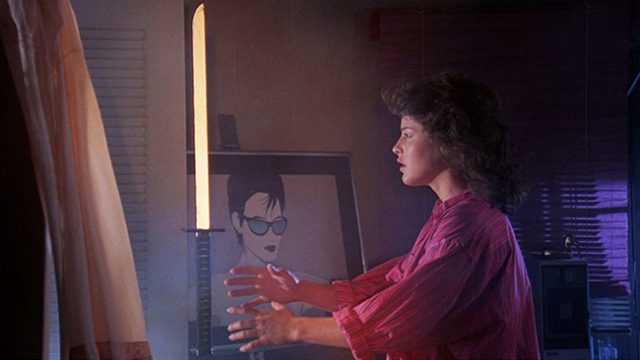If I told you Bolero was a movie with a bullfighter who gets gored in the balls and Bo Derek as his lover who learns to bullfight in his place, you’d naturally expect that to be what it focused on. But no: the bullfighter doesn’t even show up until about halfway through, and Derek never actually fights a bull. But that’s the kind of movie Bolero is. At one point, a bunch of sword-wielding goons abduct Derek in a plane, but that’s all over and forgotten in five minutes. It’s all just an excuse for the sexy stuff, but even that can be perversely unsexy or even antisexy. Just look at one scene that introduces a romantic subplot for the crusty old chauffeur played by George Kennedy with the bullfighter’s cook (who I could swear hadn’t appeared anywhere before this) grabs him with her gooey, doughy hands. Or when we see the bullfighter bathing with a nude woman in what looks like a giant mud puddle. And some of it’s downright horrifying like the way the camera leers at 14-year-old Olivia D’Abo (this seems to be a thing with Cannon), who’s naked almost as often as not, and seems even younger with the way she baby-talks her way through her tortured Spanish…ish accent.
Golan and Globus continually insisted that Bo Derek and her director/husband John add more and more sex to a movie that, as the Dereks kept telling them, already had more than enough. At one point, Bo suddenly strips naked in the middle of her bullfighting drills. “You’re a hard man to seduce,” she tells the bullfighter. Oh honey, if he was hard, there’d be no problem… All that sex backfired when the movie got slapped with an NC-17, ending the studio’s brief relationship with distributor MGM, who refused to touch it. Naturally, Golan and Globus blamed the Dereks for everything.
Missing in Action is where you can really see the dark heart of eighties Hollywood, because it’s too stupid to hide it. Chuck Norris stars as a Vietnam vet who returns to the country on a diplomatic mission before running off into the jungle to liberate his old POW camp. Apparently, it was a serious political talking point at the time that the Vietnamese army was forcing soldiers to camp out in the swamps and jungles to keep American soldiers fed and housed for nearly a decade just so they could keep torturing them. I don’t get it either.
This was actually supposed to be a sequel about Norris’s time in the war, but that movie was so bad Golan and Globus were scared it would kill the franchise before it started, so it was released the following year as Missing in Action 2: The Beginning. I couldn’t even bring myself to see how it could possibly be worse than this. But the Memento-style release schedule means that Missing in Action opens with a whole lot of sound of fury signifying not a whole lot. It’s a flashback to Norris fighting the VC, but there’s no time to establish who’s fighting who and why and over what beyond that. So all we get are a constant barrage of explosions, most of them nowhere near the bomb that allegedly causes them.
In this movie, the Vietnam War is never anything but good and right and no Vietnamese are anything but bad and wicked. That unquestioning allegiance applies to Norris’s hero, even as he does some seriously villainous shit like sneaking into a man’s bed and threatening to stab him in the throat or forcing an arms dealer to give him a discount at bazookapoint. Most horribly, he rips off a woman’s clothes and literally throws her in bed with him to convince some Vietnamese soldiers he’d been in the hotel all night. M. Emmet Walsh plays the old army buddy who takes him up the river to the POW camp, seriously testing Roger Ebert’s Stanton-Walsh rule that “no movie featuring either Harry Dean Stanton or M. Emmet Walsh in a supporting role can be altogether bad.”
Norris brags, “One of the biggest thrills of my life came when I went to a theatre to see Missing in Action, and all the people stood up and applauded at the end. That’s when my character brings some POWs he’s just rescued to a conference in Saigon, where the politicians are saying there aren’t any more prisoners of war.” If that’s not in the dictionary under “propaganda,” it ought to be. (One of those politicians, by the way, is played by the mind-bogglingly prolific Chinese-American character actor James Hong. Between this and his role as a Japanese mystic in Ninja III, Golan and Globus seem to have been determined to cast him as every nationality except his own.)
Ninja III: The Domination is the only one of these movies outside Electric Boogaloo that rises to watchability. It’s probably not a coincidence that they’re both directed by Sam Firstenberg. Both movies show he understands that you can throw in whatever ridiculous bullshit you want as long as you deliver what the audience came for: dance choreography in Electric Boogaloo and fight choreography in Ninja III. Those meat-and-potatoes thrills are just as ridiculous and anything else in both these movies, but what they lack in restraint and plausibility, they make up for in gonzo excess. Ninja III opens with an action sequence that’s equal parts awful and awesome, with a ninja slicing and dicing a bunch of boujee golfers and cops (for reasons I still haven’t figured out after watching the movie twice). He stops a golf cart by holding it one-handed. He skewers a cop’s head through the roof of his car. A car and a motorcycle go flying off a cliff like Chitty Chitty Bang-Bang. Unfortunately, not all the action scenes are this good, especially since so many of them seem to involve the ninja’s opponents throwing themselves into walls.
Ninja III also shows Firstenberg and Cannon in general’s tendency to throw a bunch of trendy shit in a blender regardless of whether it makes any sense. He reteams with Lucinda Dickey, who describes the story where she plays an aerobics instructor who the ninja possesses as a ninja movie meets The Exorcist meets Flashdance. In the Electric Boogaloo documentary, Firstenberg accidentally reveals a neanderthal sexist streak when he explains that he came up with this plot because he couldn’t think of any other way a woman could be a ninja — and then blames the movie’s box office failure on audiences not being able to buy a female ninja! Because that, of course, was the most implausible thing in this ridiculous movie.
Lucinsa Dickey’s apartment is the eigthiesest thing ever caught on film (is there a Nagel print? You betcha, and it’s eyes even glow when the ninja ghost tries to tempt her!) It also shows how Golan and Globus just dump everything in one big bucket of “stuff that’s hot right now,” since Dickey owns an arcade game box as if those were big with sexy aerobics instructors and not small children and greasy nerds, and as if that was how anyone played video games at home to begin with. The specific video game only makes things more surreal, since based on the one shot we get of the screen, it’s apparently some kind of table-waiting simulator. Surprise, surprise, it was never actually released. But I’d be falling down on my duties if I didn’t mention the ninja ghost uses it to possess Dickey by putting on a laser light show.

The miscalculation extends to the romantic subplot. Some dorky cop relentlessly harasses Lucinda Dickey when she goes to report the golf course carnage. I realized with dawning horror he was supposed to be her love interest as he calls her at home and then follows her to her aerobics class. He claims to arrest her as a pretense to get her in his car and when she explains for the trillionth time that she doesn’t date cops (clearly, ahead of her pre-ACAB times), he blows the fuck up at her. And then, for some reason, she invites him up to her room for a V-8. Later they bone. Don’t ask me to explain it. He drinks the V-8 off her neck, which I guess is supposed to be hot. He was one of the officers who unloaded several armories’ worth of explosives into the ninja, meaning the ninja ghost is out to kill him, and I have never rooted harder for a movie character’s death.
Sadly, he lives. The movie ends with a fight scene as boring as the one it started with was thrilling, as our heroes watch from the sidelines while a minor character fights the ninja ghost and some other characters we’ve never even seen before. About that: apparently, there’s a feudal Japanese castle in Ninja III’s California setting, full of martial artists for no apparent reason. The movie ends with the ninja ghost defeated, and the forces of the free market would defeat Golan and Globus by the dawning of the next decade. But they left behind them a legacy of awesome, unwatchable, and strange, strange movies.


